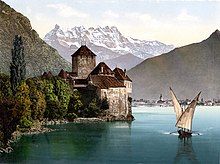Dents du Midi
| Dents du Midi | |
|---|---|
 Dents du Midi seen from Pointe Bellevue. From left to right : La Cime de l'Est, La Forteresse, La Cathédrale, l'Éperon, Dent Jaune, Les Doigts and the highest point : La Haute Cime | |
| Highest point | |
| Elevation | 3,257 m (10,686 ft) |
| Prominence | 1,796 m (5,892 ft)[1] |
| Parent peak | Mont Blanc |
| Listing | Ultra |
| Geography | |
Lua error in Module:Location_map at line 526: Unable to find the specified location map definition: "Module:Location map/data/Switzerland relief" does not exist.
| |
| Region | CH-VS |
| Parent range | Chablais Alps |
| Climbing | |
| First ascent | 1784 |
The Dents du Midi (French: "The Teeth of the South ['Le Midi' is a colloquial term for part of the South of France]") is a mountain chain situated in the Chablais Alps in the Canton of Valais, Switzerland. It is composed of seven distinct summits and reaches a height of 3257 metres (10,686 feet). Dominating the Val-d'Illiez and the Rhône Valley, to the south it faces the Lac de Salanfe, an artificial reservoir. Geologically it makes up a part of the massif Haut-Giffre.
The seven peaks
The "Dents", or "Teeth" are, from east to west:
- La Cime de l'Est (3178 metres, 10,426.51 feet)
- La Forteresse (3164 m, 10,380.58 ft)
- La Cathédrale (3160 m, 10,367.45 ft)
- L'Éperon (3114 m, 10,216.54 ft)
- Dent Jaune (3186 m, 10,452.76 ft)
- Les Doigts (3205 m, 10,515.09 ft and 3210 m, 10,531.50 ft) or Doigts de Salanfe
- La Haute Cime (3257 m, 10,685.70 ft)
Landslide

On the morning of October 30, 2006, a mass of 1,000,000 m³ (35,300,000 ft³) of rocks detached themselves from the side of the Haute Cime and fell down the side to an altitude of about 3,000 m (9,800 ft) The event did not pose any danger for the nearby town of Val-d'Illiez but roads and footpaths were closed as a security measure. According to the geologists of the canton, the landslide was caused by thawing, assisted by the hot summers of the preceding years.[2]
Origin of the name
The name "Dents du Midi" is of relatively recent origin. The native inhabitants originally called them the "Teeth of Tsallen". The present Haute Cime was then called Dent du Midi, and it eventually gave its name to the entire mountain.[3]
Each peak, or "tooth", has had several names over the centuries:
- La Cime de l'Est (Summit of the East) was called Mont de Novierre before approximately the seventeenth century, then Mont Saint Michel after the landslides of 1635 and 1636, and finally Dent Noire (Black Tooth) till the 19th century.
- Dent Jaune (The Yellow Tooth) was called the Dent Rouge (Red Tooth) until 1879.
- Les Doigts (The Fingers) were called Le Doigt de Champéry (The Finger of Champéry, 1882) then Le Doigt de Salanfe (The Finger of Salanfe, 1886) before finally just Les Doigts.
- La Haute Cime (The High Summit) also had several names: Dent de l’Ouest (Tooth of the West, 1784), Dent du Midi (Tooth of the South), Dent de Tsallen (Tooth of Tsallen), and Dent de Challent (Tooth of Challent).
L’Éperon
Several ruptures in the massif have changed the form of the peaks so much that the names adapted themselves according to the geological evolution. L’Éperon (The Spur), for example, no longer has two summits, since a landslide in the Middle Ages significantly changed this peak.
First ascents

| Name of peak | Date of first ascent[4] | Climber(s) |
|---|---|---|
| Cime de l'Est | 16 August 1842 | Nicolaz Delez |
| Forteresse | 7 June 1870 | E. Javelle and J. Oberhauser |
| La Cathédrale | 1890 | Nicolas Delez |
| L'Éperon | ? | ? |
| La Dent Jaune | 24 August 1879 | ? |
| Les Doigts | ? | ? |
| La Haute Cime | 1784[5] | Jean-Maurice Clément |
